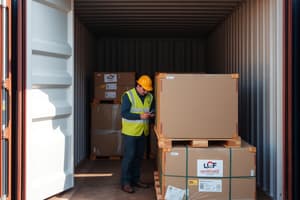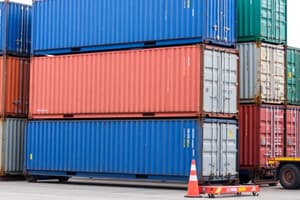Podcast
Questions and Answers
What must be done if a latch on the chassis is broken or missing during the securing of an intermodal container?
What must be done if a latch on the chassis is broken or missing during the securing of an intermodal container?
- Only secure the container with secondary attachments.
- Replace the latch before securing the container.
- Leave the latch as is and secure the container normally.
- Use an alternative means of securing the corner, such as chain or wire rope. (correct)
What is the maximum allowed forward movement of an intermodal container during transport?
What is the maximum allowed forward movement of an intermodal container during transport?
- 2.54 cm (1 in)
- 3.81 cm (1.5 in)
- 1.27 cm (1/2 in) (correct)
- No movement is allowed
How should securing devices be designed for intermodal containers on chassis vehicles?
How should securing devices be designed for intermodal containers on chassis vehicles?
- They must be lightweight for easy handling.
- They should be integral locking devices that cannot accidentally become unfastened. (correct)
- They must be adjustable and can become unfastened.
- They only need to be effective if the container is loaded.
Where must all lower corners of the intermodal container rest when positioned on a non-chassis vehicle?
Where must all lower corners of the intermodal container rest when positioned on a non-chassis vehicle?
What vertical restraint is required for securing an intermodal container?
What vertical restraint is required for securing an intermodal container?
What may be required to ensure that latches on a container remain fastened during transit?
What may be required to ensure that latches on a container remain fastened during transit?
Which of the following statements about securing empty intermodal containers on non-chassis vehicles is true?
Which of the following statements about securing empty intermodal containers on non-chassis vehicles is true?
In which direction can an intermodal container move and still be considered secured?
In which direction can an intermodal container move and still be considered secured?
What is the minimum aggregate working load limit required for tiedowns securing a loaded container?
What is the minimum aggregate working load limit required for tiedowns securing a loaded container?
Which requirement does NOT need to be met for securing empty intermodal containers on non-chassis vehicles?
Which requirement does NOT need to be met for securing empty intermodal containers on non-chassis vehicles?
When securing a container, how should each chain, wire rope, or locking device be attached?
When securing a container, how should each chain, wire rope, or locking device be attached?
What must a driver do before loading or unloading a container to ensure safety?
What must a driver do before loading or unloading a container to ensure safety?
Which of the following is NOT a key point for driver safety during container loading/unloading?
Which of the following is NOT a key point for driver safety during container loading/unloading?
What should drivers check for during the pre-loading inspection?
What should drivers check for during the pre-loading inspection?
What is the consequence of not securing the front and rear of a loaded container independently?
What is the consequence of not securing the front and rear of a loaded container independently?
For empty containers, which condition is NOT a requirement regarding hanging over the trailer?
For empty containers, which condition is NOT a requirement regarding hanging over the trailer?
Flashcards
Intermodal Container Securing
Intermodal Container Securing
Methods for securing intermodal containers on different types of vehicles (chassis and non-chassis).
Container Chassis Vehicle
Container Chassis Vehicle
A vehicle specifically designed to carry intermodal containers, featuring integrated locking systems.
Securing Loaded Intermodal Containers
Securing Loaded Intermodal Containers
Proper techniques for fastening loaded intermodal containers to ensure they don't shift or fall off during transit.
Integral Locking Devices
Integral Locking Devices
Signup and view all the flashcards
Non-Chassis Vehicle Securing
Non-Chassis Vehicle Securing
Signup and view all the flashcards
Lower Corner Resting
Lower Corner Resting
Signup and view all the flashcards
Securing Limits
Securing Limits
Signup and view all the flashcards
Securing Devices
Securing Devices
Signup and view all the flashcards
Container securing requirements
Container securing requirements
Signup and view all the flashcards
Corner Support
Corner Support
Signup and view all the flashcards
Securing methods
Securing methods
Signup and view all the flashcards
Front/rear Load Securing
Front/rear Load Securing
Signup and view all the flashcards
Tiedowns' weight limit
Tiedowns' weight limit
Signup and view all the flashcards
Empty container securing
Empty container securing
Signup and view all the flashcards
Stable container positioning
Stable container positioning
Signup and view all the flashcards
Pre-loading vehicle Inspection
Pre-loading vehicle Inspection
Signup and view all the flashcards
Study Notes
Intermodal Containers
- Intermodal containers are transported on various vehicles (chassis or non-chassis)
- Securing procedures differ depending if the container is loaded, empty, or on a chassis or non-chassis vehicle
- Loaded containers on chassis vehicles require securing using at least two latches on the chassis engage anchor points, on the front and rear of the container.
- Loaded containers on non-chassis vehicles should be secured by chains, wire ropes, or integral locking devices to all lower or upper corners of the vehicle.
- Containers must be secured to prevent:
- Movement more than 1.27 cm (1/2 inch) forward or backward
- Movement more than 1.27 cm (1/2 inch) to the left or right
- Movement more than 2.54 cm vertically (1 inch)
- Securing devices should be independently attached, and cannot come loose unintentionally.
- If a latch breaks or goes missing use alternative securing methods (e.g. chain, wire rope)
- When securing cargo inside an intermodal container, follow general cargo requirements or specific cargo guidelines.
- Empty containers on non-chassis carriers must meet four requirements:
- Balanced and stable positioning.
- Cannot hang over front/rear more than 1.5 meters (5 feet).
- Cannot interfere with vehicle maneuverability.
- Securing to prevent unintended movement.
Overview of Loading/Unloading Procedures
- Prioritize safety when loading/unloading containers.
- Park on a level surface and use parking brakes.
- Check the container and loading area thoroughly (damage, hazards, debris).
- Communicate with dock workers.
- Ensure proper lighting and use appropriate protective gear.
- Secure cargo properly using appropriate tie-down methods.
- Distribute weight evenly within the container.
- Check for shifting cargo before closing the container doors.
- Be aware of pedestrians and other vehicles in the area. Avoid pinch points when opening the doors.
- Never leave the vehicle unattended during loading/unloading.
Studying That Suits You
Use AI to generate personalized quizzes and flashcards to suit your learning preferences.
Related Documents
Description
This quiz covers the essential securing procedures for intermodal containers. It includes information on how to properly secure loaded and empty containers on various vehicles, as well as the required limits for movement. Test your knowledge on the best practices for ensuring safe transportation of intermodal containers.





